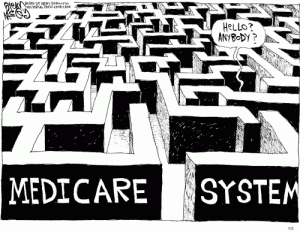By Jack Cumming
Not so long ago, Greystone Communities, the operating and community development advisers, published a blog post titled “Is Aging-in-Place the Future of Senior Living?” Given that most Americans prefer to age in place and that the senior living industry, in contrast, promotes moving from your place to ours, the title was thought-provoking.
Staying Put
Most aging Americans want to stay put in the home they love until they can’t. Responding to that, AARP has entered into a partnership with Lowe’s home improvement chain to help homeowners prepare for aging. AARP CEO Jo Ann Jenkins is quoted as saying, “The best way to continue living in the home you love is to make healthy aging improvements today that will benefit you tomorrow.”
Greystone views the same desire but through the narrow lens of the CCRC industry. While for most Americans “aging-in-place” means aging in the family home and avoiding institutionalization, Greystone’s article assumes that the term means aging in the same apartment or villa unit on an institutional CCRC campus without moving to assisted living or other higher levels of care. What’s missed is that if people don’t want to move, why would they move into a CCRC in the first place? That’s a big question that the industry struggles to answer.
Perception
With perception, Greystone recognizes that “today’s active seniors want to live where and how they want.” Most would agree with that. In fact, why wouldn’t that be true of people of any age and any era? Of course, people want to live where and how they choose. The challenge is to persuade them to choose the CCRC project that an operator offers.
Most people stay put. Others move from single family to apartment dwellings to reduce upkeep headaches. Others are attracted to the carefree margarita lifestyle of active adult living. Others move to balmy climates. And, some, a relatively small market share, move to CCRCs or similarly staged aging communities.
With an even smaller market share, a troop of resolute travelers is choosing to live permanently on a cruise ship. Market shifts happen and astute are those providers who respond proactively to the emerging trends. Most people are happy with whatever choice they make.
Keeping Old People Active
At this point, the Greystone article goes into some of the factors that can facilitate living in any of these choices. Aging in place, the article notes, is best facilitated by home design practices, inferentially meaning designing to accommodate the balance, mobility, stiffness, cognitive loss, and other challenges of old age.
Sometimes this is called universal design, with the idea that all homes, regardless of whether they’re intended for old people or not, should be suited for the elderly. Already, many facilities are required to make reasonable accommodations for people with disabilities.
Universal design would extend reasonable accommodation to homes and add accommodations for age-related conditions. The age-accommodating features noted by Greystone include “accessible kitchen counters and cabinets, wider doorways, lever-style door handles, and grab bars in bathrooms, to name a few.”
Other Eldercare Challenges
Greystone also notes the challenges of integrating home- and community-based services with the care services that CCRCs more or less incorporate into their product offerings. The diffusion of care recipients throughout a campus, as opposed to concentration in an assisted living unit, can make it difficult to coordinate and maintain care quality. That can result in a need for proportionately more staff and can increase resident isolation.
Lastly, reflecting a nod toward a questionable financing model, Greystone notes that keeping people in independent living may result in lower unit turnover with lessened cash flow from entrance fees. Of course, that assumes that entrance fees are not actuarially reserved and that forfeitures are treated as though they were deserved as fulfilled performance obligations.
The Larger Opportunity
While Greystone has looked at “aging-in-place” through the prism of its business interests, it can be constructive to take a wider perspective. Old people are reluctant to move, but they have no choice if their dependency needs escalate. Emerging robotics may ameliorate those needs and help people to avoid moving, just as car sharing services have, but that lies in the future.
The question for the industry, therefore, is not how to chart a course that serves an existing business interest, but how to restructure service delivery to conform to emerging societal and vitality patterns. That takes perceptivity and imagination, and there are precious few with those talents who are able to build responsive organizations.
What Greystone overlooked is this larger opportunity to move beyond the narrow confines of continuing care and entrance fees, and to foster with gusto and profit the larger opportunity that rapidly evolving social norms and technologies enable. The future will be for those who adapt. The others may go the way of the 19th century boardinghouses that were once one of the few acceptable livelihoods for widows and other enterprising women.









While it is true that we are a small slice of the overall pie, I find it interesting that this author is again, as he so often typically does, disparaging our thought leaders in the CCRC and IL Senior Living space. This part of senior living is a huge portion of our industry. The author’s generalized comments about aging in America are fine; but should Greystone really have to disparage itself in order to address how best to understand and adapt to the trends inside our industry that affect us all? He doesn’t like the pricing model? He thinks the majority of folks would like to stay home? What else is new? Greystone wasn’t opining about the 95% who don’t utilize our services; and why should they “take a wider view”? I don’t think Greystone missed anything. They, like all of us, are wrestling with exactly this question of “how to chart a course that serves an existing business interest, That’s what all of us who seek to adapt to the ever-changing landscape of our industry are working so hard to do. BH
Thank you BH, for your thoughts. If you’re at LeadingAge Nashville, lets meet up and talk.